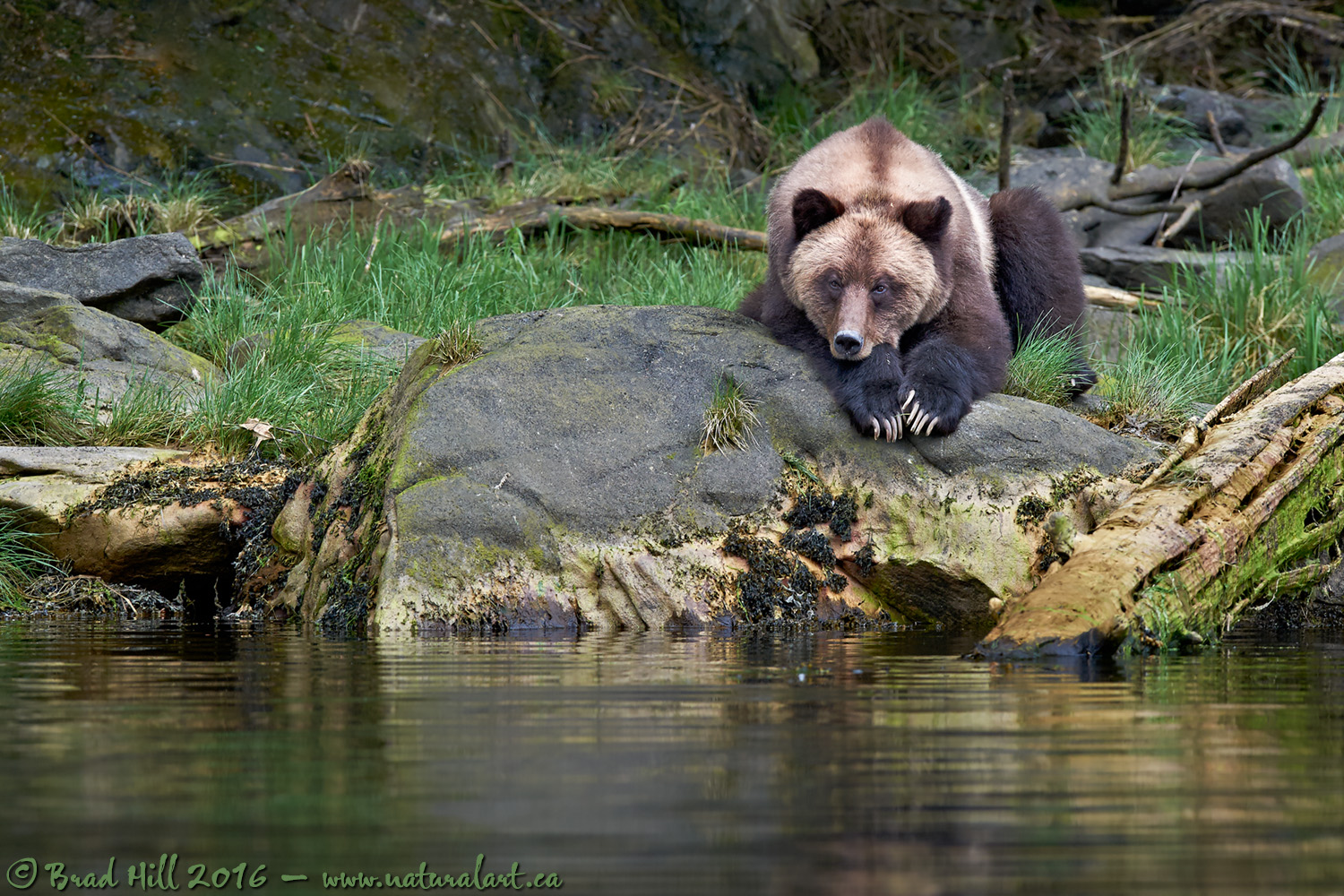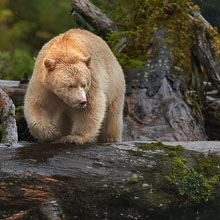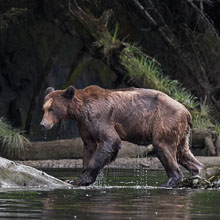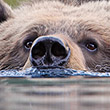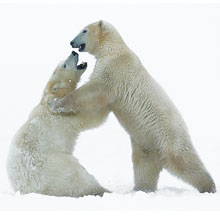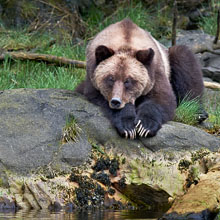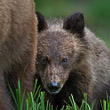Availability: Undetermined - Enquiries?
In the Field
Contemplation. Khutzeymateen Grizzly Sanctuary, northern BC coast, Canada, BC, Canada. May 25, 2011.
Spend some quality time with bears that have been treated with respect and dignity throughout their lives (and haven't been the victim of human mis-management or abuse) and one thing becomes abundantly clear in a hurry - they are intelligent, fully sentient beings. I captured this image of a young male grizzly that was in a particularly contemplative mood late one evening in the spring of 2011. Our full interaction with this bear lasted probably ten minutes, and during the entire time he never once showed any sign of alarm or discomfort. There's little I wouldn't give to know what he was pondering as he watched us watch him.
This is an image that had been sitting in my image collection since "way back" in 2011 as a "master file", but that I had done "nothing with". My standard workflow ends with the production of what I refer to as a master file - a 16-bit image in Photoshop (.psd) format with adjustment layers intact (not flattened) and in Prophoto RGB colour space. From these "master" files I can derive any final form for an image (be it a web image, an image for print, etc.) in short order. In this case, in early February of 2016 I needed an "enviroscape" or "animalscape" image suitable for a print in an exhibit on fairly short notice. I wanted a very "calming" shot that showed a grizzly in its habitat and that conveyed "thoughtfulness". A quick search of my images (yep, they're ALL keyworded) produced this shot...and it took me only a few seconds to put it in a form suitable for printing (a quick flattening of the image, followed by resizing, a colour space change, and then some final sharpening for inkjet printing).
Why the raw workflow discussion? Well...in the last few years I've been noticing that a significant number of nature photographers are "truncating" their raw workflow BEFORE producing a final "derived" master file (be it a TIFF file or a .PSD file, etc.). Instead, they use their primary raw converter (which is often Lightroom) and make a bunch of edits to the raw file - basically tweaking it to their satisfaction and then just stopping (before exporting a final, derived form of that tweaked raw file). In theory there is nothing wrong with this approach - and if that person WANTS output for a specific use (print, web image, etc.) it can be quickly produced from the edited raw file. But in practice, those edits to the file reside only in the database (catalog file) of Lightroom (or Capture One Pro, or whatever). If that catalog file becomes corrupted or "damaged" (and sometimes it's not instantly recognizable that the file has a problem), you run the risk of losing ALL your edits to ALL your raw files in that catalog. I HAVE seen people - even those with what they thought were sound back-up strategies for their catalogs - lose a few YEARS worth of editing work through catalog corruption.
My advice? Produce "master" 16-bit derived files (your choice - TIFF's or PSD's) from your most important shots and develop a separate backup strategy (including off-site storage) for those files. It's cheap insurance.
Here's a higher-resolution (2400-pixel) version of this shot that shows nicely conveys the serenity of the scene:
• Contemplation: Download 2400 pixel image (JPEG: 1.5 MB)
ADDITIONAL NOTES:
1. This image - in all resolutions - is protected by copyright. I'm fine with personal uses of them (including use as desktop backgrounds or screensavers on your own computer), but unauthorized commercial use of the image is prohibited by law. Thanks in advance for respecting my copyright!
2. This image was captured during one of my two spring "Grizzlies of the Khutzeymateen" photo tours in May/June of 2011. Each year I offer trips into two different parts of the Great Bear Rainforest as well as one to photograph aquatic mammals and oceanscapes near the northern tip of Vancouver Island. And, in selected years, I also offer photo tours to locations to capture other highly sought-after subjects, such as various boreal owl species and wildlife of Canada's Arctic. Details about these trips can be found on the Photo Tours page of this website.
3. Like all wildlife images on this website, the subject(s) is/are fully wild and completely unconstrained. Besides the potential impact of my/our presence, nothing has been done to intentionally alter or affect the ongoing behavior of the subject and, of course, there has been no use of any form of bait or other form of wildlife attractants (including vocalizations).
Behind the Camera
Contemplation. Khutzeymateen Grizzly Sanctuary, northern BC coast, Canada, BC, Canada. May 25, 2011.
Digital Capture; Compressed RAW (NEF) 14-bit format; ISO 1400.
Nikon D3s paired with Nikkor 400mm f2.8G VR. Hand-held from floating Zodiac. VR on and in "Normal" mode.
1/250s @ f5.6; no compensation from "recommended" matrix-metered exposure setting.
At the Computer
Contemplation. Khutzeymateen Grizzly Sanctuary, northern BC coast, Canada, BC, Canada. May 25, 2011.
RAW Conversion to 16-bit TIFF using Phase One's Capture One Pro. Three raw variants (different versions of a single raw capture) processed, with the variants differing only in exposure (0.7 stop total difference between the variants).
Further digital corrections on resulting 16-bit TIFF files using Adobe's Photoshop and Light Crafts Lightzone. Photoshop adjustments included compositing (blending) of the three output files from the raw converter, minor exposure tweaks, and final selective sharpening for web output. Final tone-tweaking performed using LightZone's "tonemapper" tool.
Conservation
Contemplation. Khutzeymateen Grizzly Sanctuary, northern BC coast, Canada, BC, Canada. May 25, 2011.
Ten percent of the revenue generated by this image will be donated to Raincoast*.
Species Status in Canada**: Special Concern (May 2002).
While Grizzly Bears (Ursus arctos) are not technically listed as "Endangered" in Canada, they have been extirpated from most of their historical range. Grizzly Bears are far more sensitive to intrusion/disturbance in their habitat than are Black Bears and are being increasingly forced into marginal habitat by human encroachment. The Great Bear Rainforest along the central and northern coast of British Columbia is one of the last strongholds of the Grizzly Bear in Canada, and even this population is coming under increasing pressure.
On December 18, 2017 the government of British Columbia banned grizzly hunting across the entire province. This major conservation victory came after decades of tireless work by many dedicated conservationists and ecologists and, most importantly, it reflects the opinion of the vast majority of British Columbians. And, it means that AT LEAST while the current government remains in power grizzlies are finally "safe" in British Columbia.
Now that we've at least temporarily won the battle to save grizzlies in BC, it's time to re-focus our efforts toward protecting ALL of BC's carnivores, including Gray Wolves, Black Bears, Cougars, Wolverines, and more! Simply put, there are no ecological, economic, or ethical arguments supporting the trophy hunting of carnivores.
In a great first step towards ending the hunting of carnivores throughout BC the Raincoast Conservation Foundation has developed a program designed to protect ALL carnivores within the Great Bear Rainforest. Details about this program can be found on this page on Raincoast's website. Check it out and, better yet, make a donation to help Raincoast purchase the remaining commercial hunting tenures in the Great Bear!
*The Raincoast Conservation Society (and Foundation) is an effective and efficient organization that has been fighting for protection of this unique habitat. If you are looking for a meaningful way to contribute to the conservation of this amazing ecosystem, Raincoast will provide maximal "bang" for your conservation dollars.
**as determined by COSEWIC: The Committee on the Status of Endangered Wildlife in Canada












